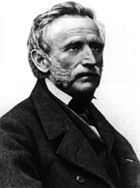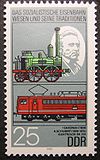
Johann Andreas Schubert
Encyclopedia


Engineer
An engineer is a professional practitioner of engineering, concerned with applying scientific knowledge, mathematics and ingenuity to develop solutions for technical problems. Engineers design materials, structures, machines and systems while considering the limitations imposed by practicality,...
(Universalingenieur), designer and university lecturer.
Life
Schubert was born on 19 March 1808 in WernesgrünSteinberg, Saxony
Steinberg is a municipality in the Vogtlandkreis district, in Saxony, Germany. It was established in 1994 by the merger of the three villages Rothenkirchen, Wernesgrün and Wildenau and named after the nearby Steinberg , part of the Ore Mountains.Wernesgrün is home of the Wernesgrüner brewery....
(Vogtland
Vogtland
The term Vogtland refers to a region reaching across the German free states of Bavaria, Saxony and Thuringia and into the Czech Republic . The name of the region contains a reference to the former leadership by the Vögte of Weida, Gera and Plauen, which translates approximately to advocates or lord...
) in the state of Saxony
Kingdom of Saxony
The Kingdom of Saxony , lasting between 1806 and 1918, was an independent member of a number of historical confederacies in Napoleonic through post-Napoleonic Germany. From 1871 it was part of the German Empire. It became a Free state in the era of Weimar Republic in 1918 after the end of World War...
in Germany
Germany
Germany , officially the Federal Republic of Germany , is a federal parliamentary republic in Europe. The country consists of 16 states while the capital and largest city is Berlin. Germany covers an area of 357,021 km2 and has a largely temperate seasonal climate...
. He was the son of a day labourer (Tagelöhner) and was brought up by foster parents, who enabled him to have a sound education at the St Thomas School
Thomasschule zu Leipzig
St. Thomas School, Leipzig is a co-educational and public boarding school in Leipzig, Saxony, Germany. It was founded by the Augustinians in 1212 and is one of the oldest schools in the world.St. Thomas is known for its art, language and music education...
in Leipzig, at the garrison school at Königstein Fortress
Königstein Fortress
Königstein Fortress , the "Saxon Bastille", is a hilltop fortress near Dresden, in Saxon Switzerland, Germany, above the town of Königstein on the left bank of the River Elbe...
and at the Freemasons Institute in Dresden
Dresden
Dresden is the capital city of the Free State of Saxony in Germany. It is situated in a valley on the River Elbe, near the Czech border. The Dresden conurbation is part of the Saxon Triangle metropolitan area....
's Friedrichstadt.
He studied civil and structural engineering (architecture) at the architecture school in the Academy of Fine Arts in Dresden and in 1828 (at the age of 20 ) was given a post as a lecturer with the reecently-founded Royal Institute for Technical Education (Königlich-Technischen Bildungsanstalt Dresden or TBD) in Dresden, the forerunner of the Dresden University of Technology
Dresden University of Technology
The Technische Universität Dresden is the largest institute of higher education in the city of Dresden, the largest university in Saxony and one of the 10 largest universities in Germany with 36,066 students...
.
On 28 April 1832 Schubert was hired as a senior professor (Prädikat Professor). He was the first lecturer in mathematical and technical sciences at the TBD and at the same time lecturer in mathematical sciences at the architecture school of the Dresden Academy of Fine Arts
Hochschule für Bildende Künste Dresden
The Dresden Academy of Fine Arts , often abbreviated HfBK Dresden or simply HfBK, is a vocational university of visual arts located in Dresden, Germany...
.
In 1836 the Maschinenbauanstalt Übigau
Maschinenbauanstalt Übigau
The Maschinenbauanstalt Übigau was a German engineering firm based in the present-day district of Übigau in the city of Dresden, Germany.- History :...
was founded and Schubert became its technical director and chairman of the board. That same year he was a co-founder of the Saxon Elbe Steamship Company (Sächsische Elbe-Dampfschifffahrts-Gesellschaft).
In 1837 the first steamship on the Upper Elbe
Elbe
The Elbe is one of the major rivers of Central Europe. It rises in the Krkonoše Mountains of the northwestern Czech Republic before traversing much of Bohemia , then Germany and flowing into the North Sea at Cuxhaven, 110 km northwest of Hamburg...
, the Königin Maria, was built and one year later the steamer, Prinz Albert, followed - both were designed by Schubert.
In April 1838 Schubert quit his contract with the mechanical engineering
Mechanical engineering
Mechanical engineering is a discipline of engineering that applies the principles of physics and materials science for analysis, design, manufacturing, and maintenance of mechanical systems. It is the branch of engineering that involves the production and usage of heat and mechanical power for the...
company and became a university lecturer again.
On 8 Apri 1839 at the opening of the first German long-distance railway between Leipzig
Leipzig
Leipzig Leipzig has always been a trade city, situated during the time of the Holy Roman Empire at the intersection of the Via Regia and Via Imperii, two important trade routes. At one time, Leipzig was one of the major European centres of learning and culture in fields such as music and publishing...
and Dresden, Schubert drove the Saxonia
Saxonia (locomotive)
The locomotive Saxonia was operated by the Leipzig-Dresden Railway Company and was the first practical working steam locomotive built in Germany. Its name means Saxony in Latin.- History :...
, the first effective, working, steam locomotive
Steam locomotive
A steam locomotive is a railway locomotive that produces its power through a steam engine. These locomotives are fueled by burning some combustible material, usually coal, wood or oil, to produce steam in a boiler, which drives the steam engine...
in Germany, which he had designed. He drove behind the official train which was hauled by two English locomotives.
On 31 May 1845 the foundation stone for the Göltzsch Viaduct
Göltzsch Viaduct
The Göltzsch Viaduct is a railway bridge in Germany. It is the largest brick-built bridge in the world, and for a time it was the tallest railway bridge in the world. It spans the valley of the Göltzsch River between Mylau and Netzschkau, around east of Reichenbach im Vogtland in the German Free...
, designed again by Schubert, was laid. Schubert made the attempt, for the first time in Germany, to base the design of railway bridges on theoretical calculations. With over 26 million bricks, the Göltzsch Viaduct is the largest brick bridge in the world. It is 574 m long, 78 m high and has 81 arches. Opened on 15 July 1851, it is still standing today, only minor maintenance being needed to enable it to cope with the loading of modern-day railway traffic.
In 1866 Johann-Andreas Schubert resigned from his university posts. On 6 October 1870 he died in Dresden. His grave is located in the Evangelical Cemetery of St Matthew's Church (Matthäuskirche) in Friedrichstrasse.
In his memory, one of the buildings at the University of Technology in Dresden's Südvorstadt district bears the name Andreas-Schubert-Bau. On the occasion of his 200th birthday in July 2008 the University organised an academic exhibition and a Schubert open day.

